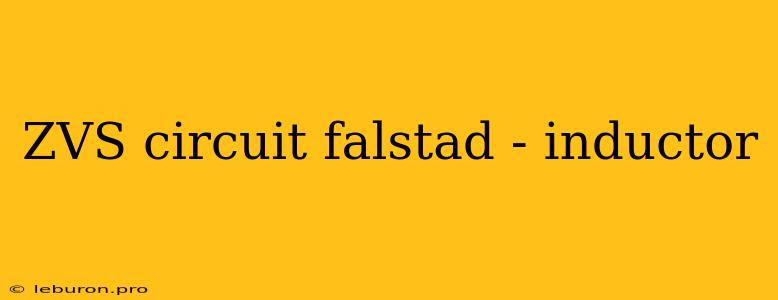The ZVS (Zero Voltage Switching) circuit is a fascinating and practical application of electronic principles, especially in the realm of resonant circuits. At its core, the ZVS circuit utilizes the inherent properties of inductors to achieve efficient energy transfer and minimize power losses. This article will delve into the fundamentals of ZVS circuits, exploring their construction, operation, and the crucial role of inductors in their functionality. We will also examine the use of Falstad, a powerful online circuit simulator, to visualize and analyze ZVS circuits.
The Fundamentals of ZVS Circuits
A ZVS circuit is a resonant converter topology that aims to switch the power devices when the voltage across them is close to zero. This method of switching minimizes switching losses, resulting in higher efficiency. The circuit typically consists of a resonant tank circuit, which includes an inductor and capacitor, a switching device (often a MOSFET), and a load.
How ZVS Works
The key to understanding ZVS lies in the interplay between the inductor and capacitor. When the switching device is turned on, energy is transferred from the DC source to the resonant tank circuit. This energy is stored in the inductor and capacitor, causing the voltage across the inductor to rise and fall sinusoidally.
At the point where the voltage across the inductor reaches zero, the switching device can be turned off without experiencing high switching losses. This is because the voltage across the device is already zero, preventing any voltage spikes or transients.
The Role of Inductors
Inductors are essential components in ZVS circuits because they store energy in a magnetic field. The inductor plays a critical role in the following ways:
- Energy Storage: As the current flowing through the inductor increases, it stores energy in its magnetic field. This stored energy is then released back into the circuit when the current decreases.
- Voltage Rise and Fall: The inductor creates a voltage across itself that opposes changes in current. This property is crucial for the sinusoidal voltage waveform that drives the ZVS switching operation.
- Resonant Frequency: The inductor's inductance, along with the capacitance of the resonant tank, determines the resonant frequency of the circuit. This frequency dictates the rate at which energy oscillates between the inductor and capacitor.
Simulating ZVS Circuits with Falstad
Falstad is a valuable tool for understanding and experimenting with ZVS circuits. This web-based circuit simulator allows you to create and analyze circuits virtually. It provides a user-friendly interface with drag-and-drop components, allowing you to build complex circuits with ease.
Benefits of Using Falstad
- Visual Representation: Falstad allows you to see the flow of current, voltage waveforms, and power dissipation within the circuit. This visual feedback helps you understand how the circuit operates.
- Parameter Adjustment: You can easily modify the values of components, such as the inductance of the inductor, and observe the effect on the circuit's behavior. This is particularly useful for optimizing ZVS circuits for specific applications.
- Experimentation: Falstad provides a safe and controlled environment for experimenting with different circuit configurations and exploring the impact of various parameters. This allows you to gain valuable insights into the principles behind ZVS circuits.
Setting Up a ZVS Circuit in Falstad
- Start with a basic resonant tank circuit: Create a circuit with a voltage source, an inductor, and a capacitor.
- Add a switching device: Use a MOSFET or other suitable switching device.
- Connect the load: Attach the load to the output of the circuit.
- Configure the components: Adjust the values of the inductor, capacitor, and switching device to achieve desired performance.
- Run the simulation: Observe the voltage and current waveforms to analyze the circuit's operation.
Applications of ZVS Circuits
ZVS circuits have various applications, including:
- Power Conversion: ZVS circuits are widely used in power supplies, inverters, and DC-to-DC converters. Their high efficiency makes them ideal for power management applications.
- RF Generators: ZVS circuits can be used to generate radio frequency signals. Their ability to produce high-frequency oscillations is useful in communication and other RF applications.
- High-Voltage Applications: ZVS circuits can operate at high voltages, making them suitable for applications such as LED drivers and electric vehicle charging systems.
Conclusion
ZVS circuits are a testament to the ingenuity of electronics engineering. Their ability to achieve high efficiency by minimizing switching losses is a critical advantage in various power electronics applications. The inductor plays a pivotal role in the operation of ZVS circuits, storing energy, influencing voltage waveforms, and determining the resonant frequency.
Falstad is a valuable tool for visualizing, analyzing, and experimenting with ZVS circuits. Its user-friendly interface and simulation capabilities make it an indispensable resource for anyone studying or working with ZVS technology. As technology continues to evolve, ZVS circuits will continue to play an important role in shaping the future of power electronics.
